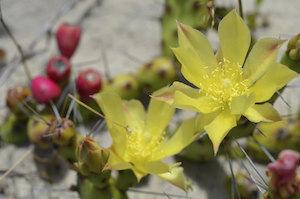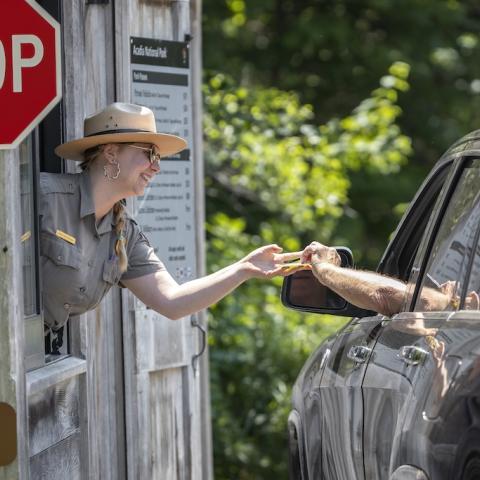
Fringed gentian in Yellowstone National Park/Diane Renkin
Editor's note: With spring here, we thought we'd reprise this article from 2017 for everyone who loves to go in search of wildflowers in the National Park System.
Delicate trilliums, glorious columbines, and flamboyant redbuds are some of the harbingers of spring found across the National Park System. This is a favorite season for birds, bees, and photographers. Wildlife is more easily seen in the spring in many parks, too, making the coming three months idyllic for exploring the parks.
Yet for those who marvel at the kaleidoscope of colors and hues that wildflowers spread across the parks, the season is unmatched. Winter’s snowmelt and the warming sun coax perennials back to life, brightening hillsides, meadows, and even forest floors.

Large-flowered trillium at Shenandoah National Park/NPS
Take the trillium, for example. Though there are more than three dozen trillium species in North America, common to these perennials is their favored habitat: partial shade and rich, moist, well-drained soil. Many units of the park system, from coast to coast, have just what they need:
- Find large, descriptively named White trilliums (T. grandiflorum) in Shenandoah National Park’s hollows in Virginia;
- Patches of Yellow trillium (T. luteum) cluster in the river bottoms of Big South Fork National River and Recreation Area on the Kentucky/Tennessee border, and;
- Clumps of Giant trillium (T. chloropetalum) climb the wooded slopes of Redwood National and State Parks in California.
Check the parks’ websites to find out if they might be blooming; they can anytime from February in Redwood to May in Big South Fork.
Desperate for redbuds? Find them in the East at Great Smoky Mountains, Shenandoah, and along the Bluestone National Scenic River in West Virginia. They’re also common at Gateway Arch National Park in St. Louis, and along the Arch Rock Entrance Road in Yosemite National Park in California, where they bloom in April.
Of course, wildflowers that bloom in the higher elevation parks of the West typically show up later than those in the East and Midwest, so there’s no need to immediately jump into your vehicle and go in search. Many can be found throughout the summer and into fall.
For example:
- Meadows are covered with Cushion phlox, Kittentails, and Aspen bluebells at Cedar Breaks National Monument in Utah, but they don’t draw much attention before July due to the comparatively late bloom at high elevation (~10,000').
- The roughly 80 wildflower species — Blue Chiming bells, Violet Shooting Stars among them — along the Cub Lake Trail in Rocky Mountain National Park in Colorado don’t show up until July.
- Interestingly shaped, and brightly red-colored, Snow plants often don’t sprout above the forest floors of Sequoia, Kings Canyon, and Yosemite national parks in California before late May and June.
- Distinctive Beargrass blooms don’t show up in Glacier National Park in Montana before June.

Beargrass is gorgeous, but doesn't always show up every year/David Restivo, Glacier National Park
Beargrass blooms don’t materialize every year, which can make them difficult to find. These stalks with their showy blooms need just the right amount of rainfall and soil moisture to sprout. Once they do, they can stand more than 4 feet tall.
If you need help identifying wildflowers, consider attending one of the annual spring wildflower festivals at Great Smoky Mountains National Park (the spring Wildflower Pilgrimage on April 23-26, Shenandoah National Park (Wildflower Weekend on May 10-11, or New River Gorge National Park and Preserve (Wildflower Weekend, April 10-13.
If you prefer to go it alone, utilize tools available through the National Park Service’s web network. Great Smoky Mountains just might have the best with its Species Mapper. This software lets you choose a particular wildflower species and find out where you’re most likely to encounter it in the park.
Another great tool is the Park Service’s NPSpecies web page. This allows you to discover which wildflowers grow in the parks.
To use this tool, go to this site, from this home page in the Get a Park Species List search insert your park of choice and click Go. This will retrieve all species known to occur in your park. You can refine the list to a particular group by selecting an option in the “Category" box, and click Search. This will return a complete list of that particular group found in the park, listed by both scientific and common name.
NPSpecies also allows you to search for specific plant species across the entire National Park System. Simply go to the “Find A Species” page from the home page, click the “Species\" box. A popup will open, select vascular plants for the “Limit to category”, select common name, type columbine in the “Search for” box. This generates a list of all species and varieties of columbine.
From that list, check the box on the specific type of columbine(s) you want to find, then click on the “Add species to search list” button. This will take you back to the "Find a Species" search page with you columbine(s) chosen where you’ll need to click on the Find a Species “Search" button. This will generate a list of parks, identified by their four-letter acronyms (e.g., CARE is for Capitol Reef National Park, FOBU is Fossil Butte National Monument), where the selected columbines are found.
In reviewing this list of parks, don’t overlook the Occurrence column, as some parks will say “Present” and others may be “Unconfirmed” or “Probably Present” with less certainty.
Another option for finding wildflowers would be to simply download a park’s wildflower list from its website. Understand, though, that not all park websites contain such lists, while some parks utilize the lists on NPSpecies, so you might start with it initially.
If you’re not a wildflower lover, that’s OK, as Great Smoky’s Species Mapper and the NPSpecies tool both allow you to also search for mammals, birds, amphibians, insects, and more.
Which national parks offer arguably the best blooms in spring? Here are some candidates:
Great Smoky Mountains National Park, straddling the North Carolina-Tennessee border, boasts 1,500 species of flowering plants, more than any other national park.

Prince's plume can be found in a number of Southwestern national parks, including Capitol Reef and Canyonlands/Patrick Cone
Shenandoah National Park in Virginia claims nearly 900 wildflower species, among them Bloodroot, which starts to push its way up through the forest duff in late March.
Grand Teton National Park in Wyoming typically sees a riot of Glacier lilies in the North Fork of Cascade Canyon, and yellow carpets of Balsam Arrowroot on valley floors.
In Yellowstone National Park in Wyoming/Montana/Idaho you’ll find Fringed gentians and Ladies tresses in geyser basins, and Yellow bells on Dunraven Pass.

Red columbine, Rocky Mountain National Park/NPS
In Arches and Canyonlands national parks in Utah you’ll see colorful bursts of Indian paintbrush all over the landscape, but you’ll have to go out after sundown to see the flowers of Sacred Datura and Yucca, which bloom at night.
Saguaro National Park in Arizona draws kudos for its April wildflower displays, a time when the Cactus Forest blooms in yellows, reds, oranges, blues, and purples thanks to its barrel and prickly pear cacti, Octillo, and Brittlebrush, just to name a few of the colorful plant blooms you’ll find here.
At Mount Rainier National Park in Washington state you’ll see various hues from lupines, Broadleaf arnica, and American bistort, which will distract your eyes from the mountain.
In Rocky Mountain National Park in Colorado, there are blue and white Colorado columbines (the Colorado state flower), showy Mountain iris, and dainty Alpine Forget-me-not.
Tallgrass Prairie National Preserve in Kansas is home to more than 500 plant species, including Prairie larkspur, four types of sunflower, Blue Wild Indigo and Fire-on-the-Mountain.
Redwood National and State Parks, California, harbors the Calypso orchid in its conifer forests, though it’s rare and can be difficult to spot. More common are Columbia lilies, Giant blazing star, and Sea fig.

Don't overlook the national seashores, such as Cape Hatteras National Seashore, where Dune prickly pear grows/NPS





 Support Essential Coverage of Essential Places
Support Essential Coverage of Essential Places






